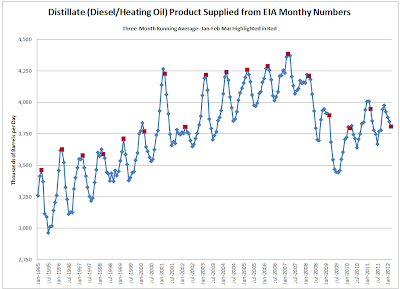Email From Lead Analyst at EIA on Petroleum Usage
Mish Moved to MishTalk.Com Click to Visit.
In response to my post 3-Month Petroleum Usage Chart for March, April, May Shows 14 Years of Supply Demand Growth has Vanished (with charts from Tim Wallace) I received a nice email from James Beck, Lead Analyst, Weekly Petroleum Status Report Team, Energy Information Administration (EIA).
Hello Mike and TimJet Fuel and Propane
I just wanted to chime in on your latest charts. As the Lead Analyst for the Weekly Petroleum Status Report at the Energy Information Administration, I appreciate that you use our numbers.
While I do appreciate the use of the weekly numbers, I wanted to send you these three charts (with all of their data included) based on the EIA's Petroleum Supply Monthly which supports your point that demand for gasoline is at 2002 levels and that total petroleum product demand is at 1997/98 levels.
Additionally, I have included the distillate demand chart which shows that since the recession began in 2008, we have had distillate demand at 2000-2002 levels, and 2012 has the second-weakest Jan-Mar level since 2002 (2012 is 0.3% higher than the Jan-Mar demand for 2010, which was the lowest since 2000).
Since diesel demand is a very good proxy for the health of the economy (all shipping uses diesel--trucking, rail, barge, etc.), this weakening might be an indication of things to come.
The reason to look at the monthly numbers is that they are more reliable than the weekly as the survey is of the entire industry and there is a great deal of extra time used to verify the data. Many people believe that the monthly numbers are a revision of the weekly numbers. This is not true. These are separate surveys. Where the monthly surveys the entire industry and collects much more detailed information, the weekly information is based on a sample of the industry drawn from the monthly reporters, collects less information, and is focused on timeliness versus completeness.
The weekly numbers are estimates of the most recent week's data based on the sample and are a snapshot in time. The weekly is a very good indicator of the data, but the monthly is the touchstone (at least until the Petroleum Supply Annual is released--which is, in fact, a revision of the monthly data).
I hope you can make use of the charts. Please let me know if I can be of further assistance.
Thank you,
James Beck
Lead Analyst,
Weekly Petroleum Supply Team
Energy Information Administration Office of Petroleum and Biofuels Statistics
In a follow-up email I asked about jet fuel and received this response.
Hello MishMonthly Delays
Seems KJet is at lowest Jan-Mar level since 1992. KJet suffered post 9/11 then with high fuel costs in 2006-2008. There has been a watershed change in how airlines operate because of the fuel cost (higher occupancy; fewer routes; different business processes for taxiing, at-gate operations, for efficient jets, etc.). Even when passenger miles recovered to pre-9/11 levels, the demand for kjet remained much lower.
Propane is highly seasonal, but even there the Jan-Mar level is lowest since 1995.
James Beck
The reason Tim Wallace uses weekly data is one of timeliness. There are long delays in waiting for monthly stats. It is nice to see that the monthly charts below confirm what Tim Wallace has been saying.
Here are the monthly charts from James Beck.
Because of seasonal variations, the proper comparison in each of the charts below is red-dot to red-dot.
Total Petroleum Usage

Diesel and Heating Oil

Gasoline

Jet Fuel

Propane

Thanks James and Tim!
Mike "Mish" Shedlock
http://globaleconomicanalysis.blogspot.com
Click Here To Scroll Thru My Recent Post List



